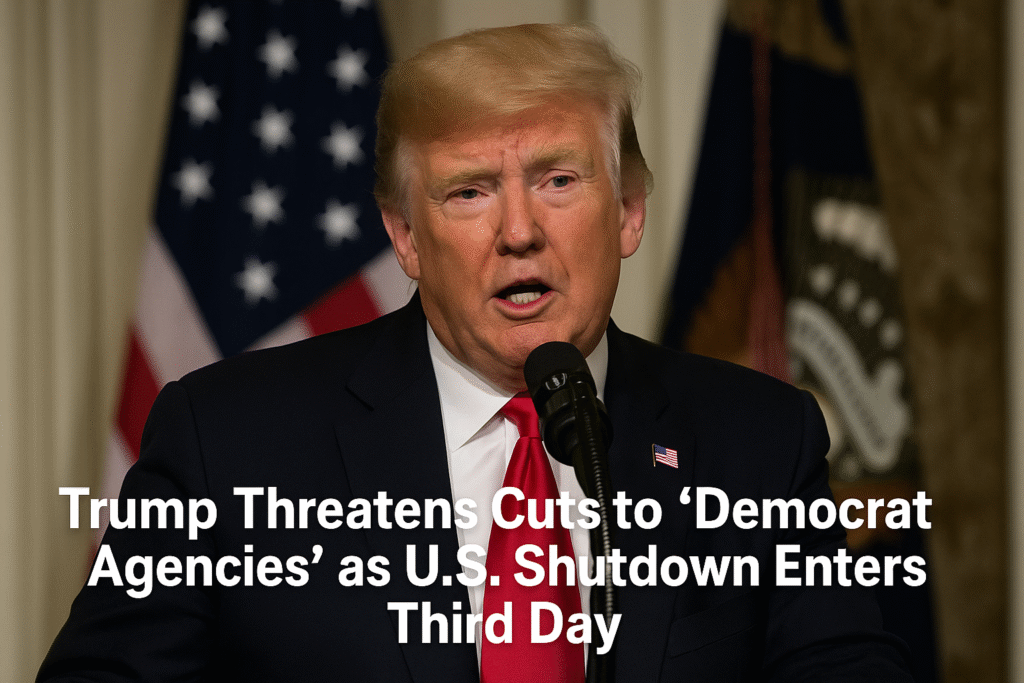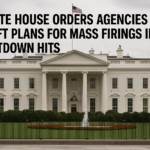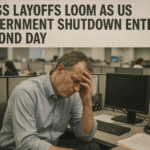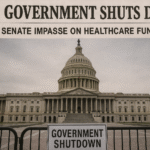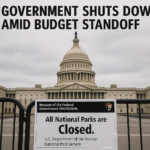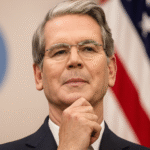By Harshit | 3 October 2025 | Washington, D.C. | 4:30 AM EDT
White House Signals Tough Approach
President Donald Trump has signaled that his administration will move ahead with targeted spending cuts as the U.S. government shutdown entered its third day on Thursday. Speaking to reporters, Trump said he and Office of Management and Budget (OMB) Director Russell Vought would meet to identify which “Democrat agencies” to cut, adding that Republicans should seize the opportunity to “clear out dead wood.”
The comments, which came as hundreds of thousands of federal workers remained at home without pay, underscored the administration’s strategy of using the shutdown as leverage in a bitter funding dispute with Democrats.
Federal Services Grinding to a Halt
The shutdown has already forced a significant portion of the federal workforce into furlough. The Congressional Budget Office (CBO) estimated that about 750,000 federal employees were expected to take unpaid leave, while more than 200,000 deemed “essential”—including law enforcement officers, air traffic controllers, and border agents—were required to continue working without pay.
Federal monuments and museums across the country have also been affected. In New York, Federal Hall, a historic site where George Washington took his oath of office in 1789, was closed to visitors. However, other landmarks, such as the Statue of Liberty and Ellis Island, remained open, with the Department of the Interior crediting Trump for ensuring continued operations.
Tourists in Washington, D.C., reported being turned away from several Smithsonian museums, while conservation groups urged Americans to avoid visiting national parks, citing risks to public safety and environmental damage during the shutdown.
The Dispute in Congress
At the heart of the standoff is a disagreement over healthcare subsidies for low-income Americans. Democrats have insisted that renewal of these subsidies must be part of any government funding bill. Republicans, however, have demanded a “clean” spending measure without additional provisions.
House Speaker Mike Johnson on Thursday labeled the impasse a “Democrat shutdown” and accused the opposition of being unwilling to compromise. “Democrats are being selfish,” Johnson said in a Capitol Hill press conference, adding that Republicans would not negotiate on attaching health insurance measures to government funding.
Democrats pushed back forcefully. House Minority Leader Hakeem Jeffries accused Republicans of disregarding the needs of working-class Americans. “They don’t want to provide healthcare, and Trump’s threats to fire more federal workers are pointless. They’ve been firing federal employees all along,” Jeffries told reporters.
The Senate is expected to hold another vote on a short-term funding bill on Friday, though analysts say neither party has shown signs of compromise. Republicans currently control both chambers of Congress but lack the 60 Senate votes required to advance a funding bill without bipartisan support.
Political Calculations and Public Opinion
Both parties have tried to frame the narrative of the shutdown to their advantage. Trump and his allies argue that Democrats are obstructing government funding in order to secure healthcare benefits that, they claim, are costly and unnecessary. Democrats, meanwhile, accuse Republicans of trying to dismantle healthcare protections for vulnerable populations.
Lee Miringoff, director of the Marist Institute for Public Opinion, noted that his polling indicates a sharp partisan divide. “Majorities of both Democrats and Republicans blame the other party for the shutdown, while 41% of independents believe both share responsibility,” he said.
Miringoff added that broader public pressure may eventually push lawmakers toward compromise, but that is unlikely until Americans begin to feel the personal effects of a prolonged government shutdown. “Both of the parties have mastered the finger-pointing,” he said, “and all we’re left with is a growing number of people who think the country is headed in the wrong direction.”
Economic and Social Impact
While immediate effects remain limited for many households, economists warn that a shutdown lasting several weeks could cost the U.S. economy billions in lost productivity. Essential federal programs, including food assistance and disaster relief, could face disruptions if the impasse continues.
Air travel is expected to continue for now, though some analysts warn of potential delays if unpaid Transportation Security Administration (TSA) workers and air traffic controllers begin calling in sick, as occurred during the 2018 shutdown.
For the hundreds of thousands of federal workers currently on furlough, uncertainty remains the central concern. Past shutdowns have eventually seen furloughed employees repaid, but this time White House officials, including Vice President JD Vance, have warned that permanent job cuts could follow if the standoff drags on.
Outlook
As the shutdown stretched into Thursday, lawmakers and the administration appeared no closer to compromise. Trump has given no indication of backing down, instead framing the crisis as an opportunity to reshape federal spending priorities.
With negotiations stalled and another Senate vote not expected until Friday afternoon, the government closure could extend into the weekend. For now, hundreds of thousands of federal workers and millions of Americans who rely on government services are left waiting to see whether political brinkmanship will give way to a deal—or to deeper cuts.

